Hardness of Approximation for H-Free Edge Modification Problems
Authors Ivan Bliznets, Marek Cygan, Pawel Komosa, Michal Pilipczuk
-
Part of:
Volume:
Approximation, Randomization, and Combinatorial Optimization. Algorithms and Techniques (APPROX/RANDOM 2016)
Part of: Series: Leibniz International Proceedings in Informatics (LIPIcs)
Part of: Conference: International Conference on Randomization and Computation (RANDOM)
Part of: Conference: International Conference on Approximation Algorithms for Combinatorial Optimization Problems (APPROX) - License:
 Creative Commons Attribution 3.0 Unported license
Creative Commons Attribution 3.0 Unported license
- Publication Date: 2016-09-06
File

PDF
LIPIcs.APPROX-RANDOM.2016.3.pdf
- Filesize: 0.56 MB
- 17 pages
Document Identifiers
Subject Classification
Keywords
- hardness of approximation
- parameterized complexity
- kernelization
- edge modification problems
Metrics
- Access Statistics
-
Total Accesses (updated on a weekly basis)
0Document
0Metadata
Abstract
The H-free Edge Deletion problem asks, for a given graph G and integer k, whether it is possible to delete at most k edges from G to make it H-free, that is, not containing H as an induced subgraph. The H-free Edge Completion problem is defined similarly, but we add edges instead of deleting them. The study of these two problem families has recently been the subject of intensive studies from the point of view of parameterized complexity and kernelization. In particular, it was shown that the problems do not admit polynomial kernels (under plausible complexity assumptions) for almost all graphs H, with several important exceptions occurring when the class of H-free graphs exhibits some structural properties. In this work we complement the parameterized study of edge modification problems to H-free graphs by considering their approximability. We prove that whenever H is 3-connected and has at least two non-edges, then both H-free Edge Deletion and H-free Edge Completion are very hard to approximate: they do not admit poly(OPT)-approximation in polynomial time, unless P=NP, or even in time subexponential in OPT, unless the Exponential Time Hypothesis fails. The assumption of the existence of two non-edges appears to be important: we show that whenever H is a complete graph without one edge, then H-free Edge Deletion is tightly connected to the \minhorn problem, whose approximability is still open. Finally, in an attempt to extend our hardness results beyond 3-connected graphs, we consider the cases of H being a path or a cycle, and we achieve an almost complete dichotomy there.
Cite As Get BibTex
Ivan Bliznets, Marek Cygan, Pawel Komosa, and Michal Pilipczuk. Hardness of Approximation for H-Free Edge Modification Problems. In Approximation, Randomization, and Combinatorial Optimization. Algorithms and Techniques (APPROX/RANDOM 2016). Leibniz International Proceedings in Informatics (LIPIcs), Volume 60, pp. 3:1-3:17, Schloss Dagstuhl – Leibniz-Zentrum für Informatik (2016)
https://doi.org/10.4230/LIPIcs.APPROX-RANDOM.2016.3
BibTex
@InProceedings{bliznets_et_al:LIPIcs.APPROX-RANDOM.2016.3,
author = {Bliznets, Ivan and Cygan, Marek and Komosa, Pawel and Pilipczuk, Michal},
title = {{Hardness of Approximation for H-Free Edge Modification Problems}},
booktitle = {Approximation, Randomization, and Combinatorial Optimization. Algorithms and Techniques (APPROX/RANDOM 2016)},
pages = {3:1--3:17},
series = {Leibniz International Proceedings in Informatics (LIPIcs)},
ISBN = {978-3-95977-018-7},
ISSN = {1868-8969},
year = {2016},
volume = {60},
editor = {Jansen, Klaus and Mathieu, Claire and Rolim, Jos\'{e} D. P. and Umans, Chris},
publisher = {Schloss Dagstuhl -- Leibniz-Zentrum f{\"u}r Informatik},
address = {Dagstuhl, Germany},
URL = {https://drops.dagstuhl.de/entities/document/10.4230/LIPIcs.APPROX-RANDOM.2016.3},
URN = {urn:nbn:de:0030-drops-66260},
doi = {10.4230/LIPIcs.APPROX-RANDOM.2016.3},
annote = {Keywords: hardness of approximation, parameterized complexity, kernelization, edge modification problems}
}
Author Details
References
-
N. R. Aravind, R. B. Sandeep, and Naveen Sivadasan. Parameterized lower bound and NP-completeness of some h-free edge deletion problems. In COCOA 2015, volume 9486 of LNCS, pages 424-438. Springer, 2015.

-
Ivan Bliznets, Marek Cygan, Paweł Komosa, Lukáš Mach, and Michał Pilipczuk. Lower bounds for the parameterized complexity of Minimum Fill-in and other completion problems. In SODA 2016, pages 1132-1151. SIAM, 2016.

-
Leizhen Cai. Fixed-parameter tractability of graph modification problems for hereditary properties. Inf. Process. Lett., 58(4):171-176, 1996.

-
Leizhen Cai and Yufei Cai. Incompressibility of H-free edge modification problems. Algorithmica, 71(3):731-757, 2015.

-
Yufei Cai. Polynomial kernelisation of H-free edge modification problems. Master’s thesis, The Chinese University of Hong Kong, 2012. Available at author’s website.

-
Marek Cygan, Marcin Pilipczuk, Michał Pilipczuk, Erik Jan van Leeuwen, and Marcin Wrochna. Polynomial kernelization for removing induced claws and diamonds. CoRR, abs/1503.00704, 2015. To appear in the proceedings of WG 2015.

-
Pål Grønås Drange, Fedor V. Fomin, Michał Pilipczuk, and Yngve Villanger. Exploring the subexponential complexity of completion problems. TOCT, 7(4):14, 2015.

-
Archontia C. Giannopoulou, Daniel Lokshtanov, Saket Saurabh, and Ondrej Suchý. Tree deletion set has a polynomial kernel (but no OPT^O(1) approximation). In FSTTCS 2014, volume 29 of LIPIcs, pages 85-96. Schloss Dagstuhl - Leibniz-Zentrum fuer Informatik, 2014.

-
Sylvain Guillemot, Frédéric Havet, Christophe Paul, and Anthony Perez. On the (non-)existence of polynomial kernels for P_𝓁-free edge modification problems. Algorithmica, 65(4):900-926, 2013.

-
Russell Impagliazzo and Ramamohan Paturi. On the complexity of k-SAT. J. Comput. Syst. Sci., 62(2):367-375, 2001.

- Sanjeev Khanna, Madhu Sudan, Luca Trevisan, and David P. Williamson. The approximability of constraint satisfaction problems. SIAM Journal on Computing, 30(6):1863-1920, 2001. URL: http://dx.doi.org/10.1137/S0097539799349948.
-
Stefan Kratsch and Magnus Wahlström. Two edge modification problems without polynomial kernels. Discrete Optimization, 10(3):193-199, 2013.

-
Daniel Lokshtanov, Dániel Marx, and Saket Saurabh. Lower bounds based on the exponential time hypothesis. Bulletin of the EATCS, 105:41-72, 2011.

-
Assaf Natanzon. Complexity and approximation of some graph modification problems. Master’s thesis, Department of Computer Science, Tel Aviv University, 1999.

